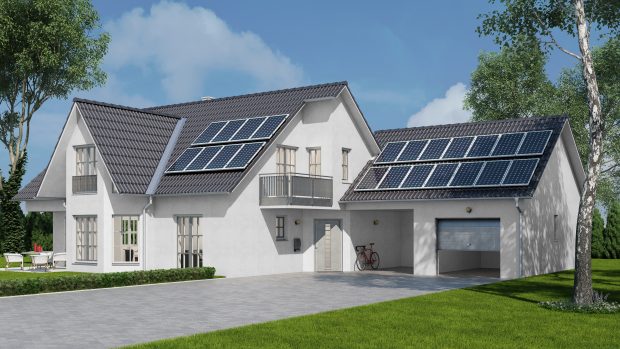 Credit/Shutterstock
Credit/Shutterstock
The credit union movement's long history of serving as financial first responders is once again being recognized. With the help of a new federal program, the $27 billion Greenhouse Gas Reduction Fund (GGRF), credit unions are now poised to help their members in low-income and disadvantaged communities who are grappling with rising energy costs and challenges like extreme heat. GGRF is made up of three grant competitions: Clean Communities Investment Accelerator (CCIA), National Clean Investment Fund (NCIF) and Solar For All (SFA).
Inclusiv is proud to have been selected for a $1.87 billion CCIA grant to enable credit unions to deliver energy efficiency, electrification and solar access to consumers, homeowners and small businesses in low-income and disadvantaged communities. Through CCIA, Inclusiv will expand the training and technical assistance that has supported hundreds of credit unions to launch green lending programs and deliver capitalization grants to scale this lending across the country. Credit unions, with their deep expertise in serving low-income and disadvantaged communities, are uniquely positioned to deliver the financing that will help low-income credit union members lower their energy bills and improve their quality of life through GGRF.
Recommended For You
Low- and moderate-income people spend a disproportionately large share of their income on energy bills. Higher energy costs mean that low-income communities and communities of color are paying more of their income to heat their homes in the winter and cool their homes in the summer. According to Department of Energy data and a report from the American Council for an Energy-Efficient Economy (ACEEE), the energy burden (the percentage of household income spent on home energy bills) is three times higher for low-income households than the median energy burden for non-low-income households. African American households have an energy burden that is 43% higher than that of non-Hispanic white households. For Native American households, it is 45% higher, and for Hispanic households, it is 20% higher.
The Greenhouse Gas Reduction Fund was one component of the Inflation Reduction Act, which included tax credits and rebates to help households to transition to cheaper and more efficient energy sources affordably. A key component of the Inclusiv strategy is to support credit unions to work in conjunction with local contractors and installers, as well as with community partners to help their members access these subsidies.
With our member-first philosophy and focus on financial health, credit unions are central to delivering financing while strengthening the household budget. We've seen green lending programs take off through our Center for Resiliency and Clean Energy. Since 2019, the Center, in partnership with the Carsey School of Public Policy at the University of New Hampshire, has trained close to 400 community-based financial institutions in how to design affordable and accessible clean energy loan products. The results have been impressive. Reporting from just a sample of 70, these lenders have made $3.38 billion in green loans in the past five years.
One of these lenders is the $205 million Tucson Old Pueblo Credit Union (TOPCU), a CDFI that serves more than 17,000 members in Tucson, Ariz. TOPCU offers a green loan program that finances many energy-saving projects for all in their community, including low- and moderate-income communities, communities of color, underbanked populations and energy-burdened households. TOPCU recently helped a borrower qualify for a local incentive to reduce his solar installation costs. Before installing solar, he could only afford to run his air conditioner for two to three hours a day, which is very difficult in the summer months in Arizona, where temperatures can rise to well over 100 degrees Fahrenheit. However, with solar installed, he can now afford to run his air conditioner whenever he needs it, vastly improving his comfort level and quality of life.
This lending leverages partnerships with local utilities, nonprofits and government agencies to provide rebates and other incentives that reduce energy costs. They are made possible through the types of on-the-ground knowledge and relationships that credit unions form throughout their communities. This is how to create market transformation and examples like these demonstrate the central role credit unions can play in ensuring the benefits of the Inflation Reduction Act reach low-income and disadvantaged communities they were intended to reach.
The Greenhouse Gas Reduction Fund offers an unprecedented opportunity to increase climate resilience and drive climate and energy justice. Bringing the financial health benefits of clean energy to low-income and disadvantaged communities while supporting local small businesses to provide clean energy services is a natural fit for credit unions. Delivering training, technical assistance and financial investment to credit unions is what Inclusiv is uniquely suited to do. We are excited to be working with credit union leagues and associations and valued partners across the movement in the coming months to deliver information sessions, webinars, trainings and engagement opportunities to share more about this opportunity.
Together, we intend to build and strengthen credit unions to be central players in a greening economy, providing safe, affordable and innovative lending that make more resilient and prepared households, businesses and communities. This is a once-in-a-generation opportunity for the entire credit union community to step forward and fulfill our mission. Let's seize it.
 Cathie Mahon
Cathie Mahon Cathie Mahon is President/CEO of Inclusiv in New York, N.Y.
© Touchpoint Markets, All Rights Reserved. Request academic re-use from www.copyright.com. All other uses, submit a request to [email protected]. For more inforrmation visit Asset & Logo Licensing.






